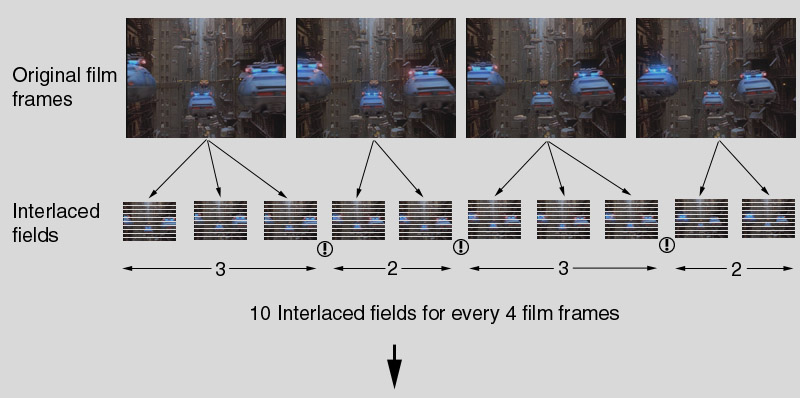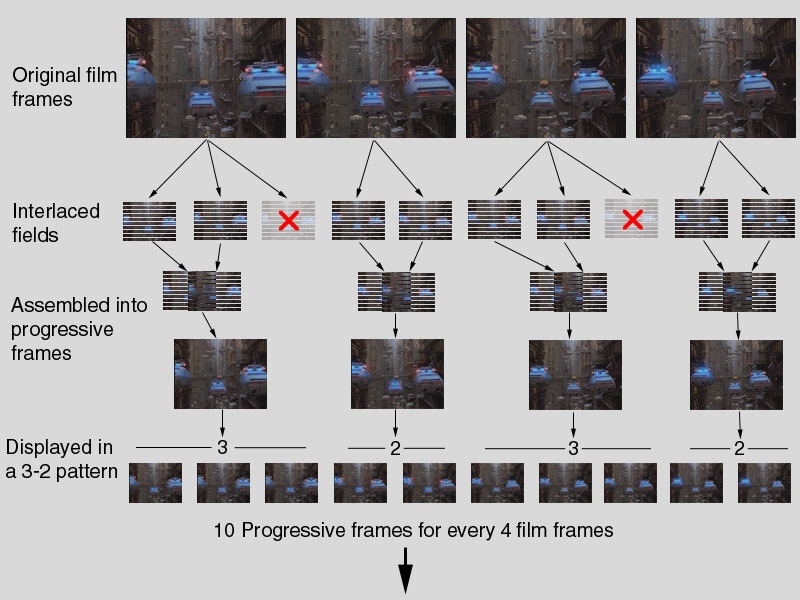No, that's not how I understood it.
For purposes of clarity, let's divide the text into 3 parts:
1.
Progressive Cinema Scan (3/2 Pulldown) achieves exceptionally faithful movie reproduction through a sophisticated analog-to-digital conversion.The first part states the name of the proprietary tech, "Progressive Cinema Scan (3/2 Pulldown)", and refers to it as an "analog to digital conversion".
2.
Movies on film are converted to NTSC interlaced video (480i) for television by a process known as telecine conversion, in which the 24 frame-per-second film is converted to video at 60 fields per second. The fields are then paired to create 30-frame-per-second 480i video. Some of the frames will contain dissimilar pairs of fields derived from two different frames of the original film, which causes artifacts. The next part discusses the telecine process, and describes how telecine can cause artifacts as a result of the 24 fps and 30 fps difference. Note that this part is discussing telecine only; it does not mention anything about Panny's Progressive Cinema Scan technology.
 http://www.hometheaterhifi.com/volume_7_4/dvd-benchmark-part-5-progressive-10-2000.html
http://www.hometheaterhifi.com/volume_7_4/dvd-benchmark-part-5-progressive-10-2000.html3.
Panasonic's Progressive Cinema Scan circuitry converts 480i video to 480p while restoring the original frames of the film for a more authentic movie reproduction. This widescreen TV features a width-to-height ratio similar to movie theater screens, providing a theater-like experience at home. View HDTV broadcasts and widescreen DVDs the way they were meant to be seen.The last part discusses Panasonic's progressive scanning (conversion of interlaced video to progressive video), then the screen's aspect ratio.
There's nothing new about the phrase, "while restoring the original frames of the film for a more authentic movie reproduction". That is what progressive scanning is supposed to do --- assemble pairs of interlaced fields into one progressive frame, and show it in a manner which will emulate the original 24fps speed.
But it still won't be a 1:1 frame conversion. There will still be 10 progressive video frames for every 4 film frames:
 http://www.hometheaterhifi.com/volume_7_4/dvd-benchmark-part-5-progressive-10-2000.html
http://www.hometheaterhifi.com/volume_7_4/dvd-benchmark-part-5-progressive-10-2000.html----------------------------------------------
Clearly, Panasonic is discussing progressive scanning, not 24p technology.
The text was written for marketing purposes. It gives you an impression that the model has some high tech 24p capability when it does not. Yet it was so cleverly written that after a close scrutiny, you will find that you cannot fairly accuse Panasonic of false advertising.
I assure you, if that TV were 24p capable, they would have simply said so in no uncertain terms.

---------------------------------------------
Sir is this "pulldown" the same as the one found in the Panny PX500 Plasma?
No, the pulldown is already there. The Panny merely adds progressive scanning.
2:3 pulldown is performed during telecine conversion of film to video. It is done during the encoding of the scanned film frames to video format.
http://en.wikipedia.org/wiki/Telecine#2:3_pulldownThe video encoded on the disc had already been pulled down to 30 fps during the encoding process. Assuming that the interlaced video was converted to progressive by the DVD player, all the TV has to do is display the progressively-scanned image.
But if the DVD player merely passes an interlaced video signal to the TV, the latter converts the interlaced video to progressive before displaying it on screen. And that's all that Progressive Cinema Scan does.
Read that part again:
Panasonic's Progressive Cinema Scan circuitry converts 480i video to 480p while restoring the original frames of the film for a more authentic movie reproduction. So could we safely say that the 1080p/24 tech is the advanced version of the feature stated above?
No, not even close. The feature in question is just a cleverly presented progressive scanning capability (the techier term is deinterlacing

).
In 1080/24p tech, it is not enough that the TV is 24p capable; the disc itself must also be encoded in 24p.